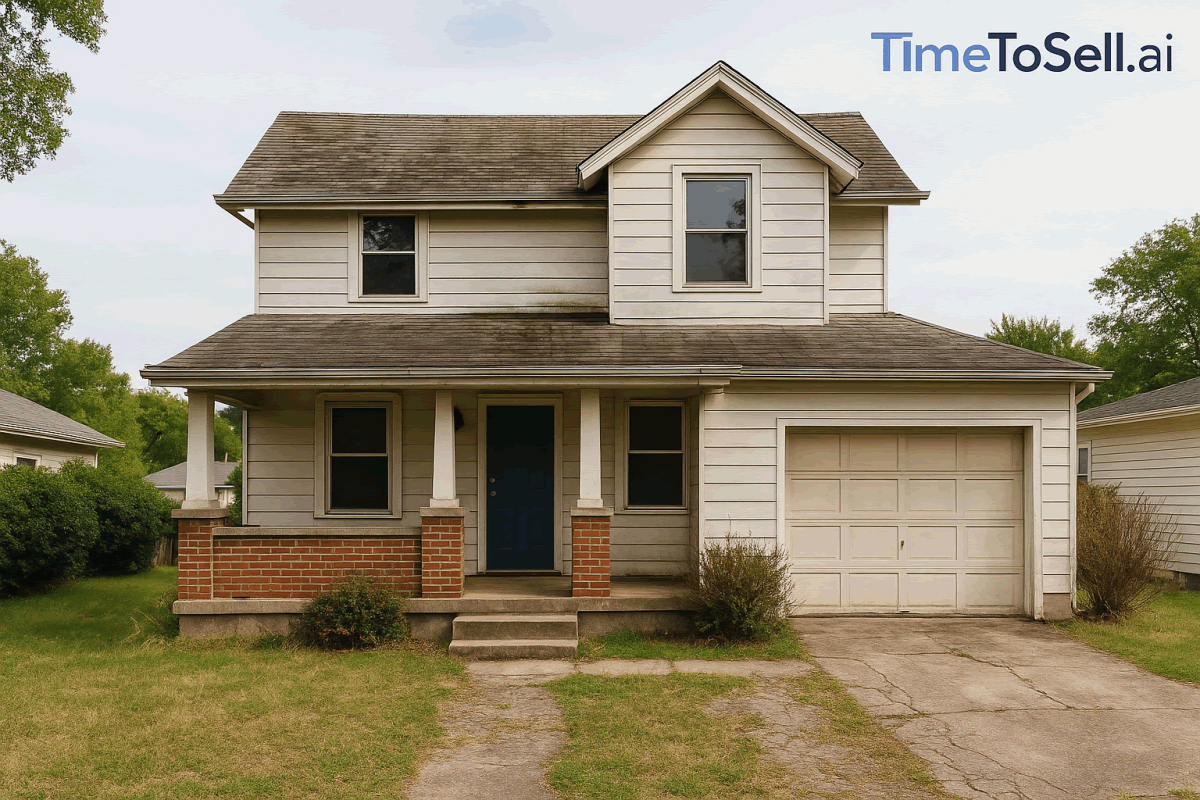A Personal Note from Your AI Portfolio Advisor: The data associated with your property indicates it is a non-owner-occupied asset with characteristics suggesting high maintenance requirements. For a remote owner, this combination often creates a significant but difficult-to-quantify drain on both time and net returns. This document is a strategic briefing designed to provide a data-driven framework for analyzing your asset’s total performance and exploring exit strategies to optimize your portfolio and your life.
1. The Myth of Passive Income: When an Asset Becomes an Anchor
The promise of rental property ownership is often sold as “passive income.” In a perfect world, the rent arrives, the mortgage is paid, and the asset appreciates quietly in the background. For many owners of newer, low-maintenance properties, this can be a reality.
However, for an absentee owner of an older or physically demanding property—one with a large lot, mature trees, or aging systems—the reality is often the opposite. The “passive” asset becomes a second, unpaid job. This is the core of the Investor Exit Wave: a growing cohort of landlords realizing their asset has become an anchor.
Late-night calls about a broken pipe, the endless search for a reliable local handyman, disputes with tenants, and the constant, low-grade anxiety about what might go wrong next—this is the lived experience of managing a burdensome asset from hundreds or thousands of miles away. At this point, a professional investor must ask a critical question: What is the true, fully-loaded cost of this investment?
2. Quantifying the Invisible Burden: The "Total Management Drag" Audit
To make an objective decision, you must conduct a performance audit that goes beyond a simple P&L statement. You must quantify the “Total Management Drag”—the combined financial, time, and risk costs that are eroding your returns and your peace of mind.
Part 1: The Financial Drag
This goes deeper than just subtracting expenses from rent. It requires an honest accounting of costs that don’t always show up on a monthly statement.
- Rising Operating Costs: Insurance premiums in Colorado are a prime example of a cost that is surging, a key factor in the Insurance & HOA Shock playbook. For older homes, these costs are often even higher.
- Capital Expenditure (CapEx) Reserves: A 30-year-old roof is a multi-thousand-dollar liability waiting to happen. A professional investor allocates 1-2% of the property's value annually to a CapEx fund. Are you including this in your calculations?
- Vacancy & Turnover Costs: Every time a tenant leaves, you incur real costs: lost rent during the vacancy, professional cleaning, marketing for a new tenant, and leasing commissions. For a $2,500/month rental, a single month of vacancy is a $2,500 loss.
Part 2: The Time Drag (The Cost of Your Hours)
This is the most overlooked but most significant cost for a remote landlord. Your time is a finite and valuable asset. You must assign it a dollar value.
| Task | Estimated Hours per Month | Your Hourly Rate | Monthly Time Cost |
|---|---|---|---|
| Tenant Communication | 2-4 hours | $75/hour | $150 - $300 |
| Vendor Sourcing & Management | 3-5 hours | $75/hour | $225 - $375 |
| Bookkeeping & Admin | 1-2 hours | $75/hour | $75 - $150 |
| Total Monthly Time Cost | $450 - $825 (or $5,400 - $9,900 per year) | ||
This is a conservative estimate. A single major repair can consume dozens of hours. This “time cost” must be subtracted from your cash flow to see your true return.
Part 3: The Risk & Stress Drag
This is the unquantifiable but most deeply felt cost. It’s the mental energy consumed by worrying about a property you can’t see. It’s the stress of a potential legal issue with a tenant, or the fear of a major system failure. This “stress drag” has a real impact on your quality of life and is often the final catalyst for deciding to sell.
3. The Strategic Solution: The Two-Path Exit Memo
If your audit reveals that the asset is underperforming, the next step is to analyze your exit options with a clear, documented framework. This is the same “Two-Path Memo” used for professional estate dispositions, as detailed in the Estate Sales Playbook.
Path A: The Turnkey Liquidation (Sell As-Is, Tenant in Place)
This involves a direct, private sale to another investor with your tenant remaining in the property.
- The Advantage: This is the path of maximum simplicity and speed. It eliminates all logistical friction—no tenant move-out, no repairs, no showings. It provides a clean, predictable closing and immediately stops the management drag.
- The Trade-off: The buyer pool is limited to investors, and the price will be based on the property’s performance (cap rate), which is typically lower than its value to an owner-occupant.
Path B: The Value Maximization Sale (Vacate & Refresh)
This involves coordinating a tenant move-out, investing in a light cosmetic refresh (paint, carpet, fixtures), and selling the property on the open market to a retail homebuyer.
- The Advantage: This path almost always yields the highest net proceeds, as you are selling an appealing “home” rather than a rental “asset.”
- The Trade-off: It requires more upfront capital and a longer timeline. However, the key is to partner with a professional who can act as your on-the-ground project manager, making this a “hands-off” process for you. This is the core of a modern brokerage’s service, as detailed in the Listing Operations Manual.
4. The Ultimate Simplification: The 1031 Exchange
For a tired landlord, the 1031 Exchange is more than just a tax strategy; it is a lifestyle strategy. It allows you to sell your high-maintenance, hands-on rental property and redeploy 100% of the proceeds, tax-deferred, into a truly passive real estate investment.
Imagine swapping the headaches of your current property for:
- A NNN (Triple-Net) Lease Property: A commercial property where the tenant (often a national brand like Starbucks or Dollar General) is responsible for all taxes, insurance, and maintenance. Your only job is to collect a check.
- A Delaware Statutory Trust (DST): A fractional ownership interest in a large, institutional-grade property (like an apartment complex or medical office building) managed by a professional firm.
- A portfolio of newer, low-maintenance rentals in a market with better long-term growth prospects.
This is the ultimate endgame for many investors: converting a hands-on asset into a hands-off income stream.
5. The Execution: Finding a Strategic Partner Who is a Fiduciary and Project Manager
Liquidating a rental property from a distance requires more than just a real estate agent. You need a strategic partner with a specific skill set:
- An Investor Mindset: They must be fluent in the language of NOI, CapEx, and 1031 exchanges, as detailed in the Equity Math guide.
- A Project Management System: They must have a proven, documented process for managing tenant move-outs, coordinating vendors, and providing you with regular, transparent updates.
- A Network of Professionals: They should have a vetted list of local contractors, property managers, and Qualified Intermediaries to facilitate a 1031 exchange.
The Takeaway: Your investment property should be an asset that serves your financial goals, not a job that consumes your time and energy. A disciplined, data-driven audit of its true performance is the first step toward making a strategic decision. By analyzing your options and partnering with the right professional, you can liquidate a burdensome asset and redeploy your capital in a way that truly aligns with your long-term goals for financial freedom and peace of mind.
To begin your asset performance review, access your complimentary TimeToSell.AI dashboard. It provides the initial valuation data and market insights needed to model your disposition scenarios and plan your next strategic move.





